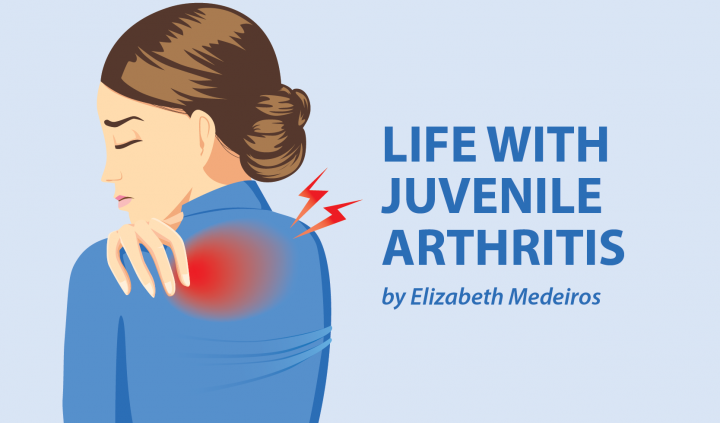Everyone says I’m a homebody, and they’re not wrong. As much as I love to go out and have adventures, I spend a lot of time at home. It’s where I’m most comfortable. Not only is it filled with my favorite colors, flowers, and materials, but also it’s the most accommodating place for me.
As someone with JA, being home is sometimes a relief because I don’t need to worry if the place I’m visiting will be arthritis-friendly. For example, I know all the doors at my house are light enough to push open, which isn’t the case at the store. And I’m allowed to keep my shoes on if my feet are bothering me, which may not be permitted if I’m a guest in someone else’s house.
I think it’s important for all kids with JA to feel comfortable at home. Having a place to unwind with as few pain triggers as possible is so valuable. While there are many ways to make the house more comfortable, I would start looking at the following four areas:
1. Soft rugs on hard floors
I’m a big fan of the hardwood in my parlor and dining room. But gosh, these surfaces can be so painful to walk on for someone with JA, particularly in the joints and tendons of their feet and legs. So while I love my hardwood, I’ve put down soft, floral rugs to save my feet.
To make walking around less painful for your child, you can put down nice, soft carpets. Laying foam floor mats next to your sink, dishwasher, and clothes dryer can make helping with chores less painful, too.
If you’re not a carpet person, a pair of soft, cushioning slippers can also go far. The thicker the sole, the better. My favorite slippers are the Dearfoams brand, which can be found at Walmart. They come in both kid and adult sizes. If your younger child refuses to wear slippers, you could have a pair of “house sneakers” for them.
2. Comfortable mattresses
When staying at a hotel, one never knows how the beds will be. Will the mattress be comfortable or will it feel like sleeping on a rock? On a recent vacation, I had to sleep on the couch because the beds were not of good quality, and I couldn’t lie down for more than a half-hour without experiencing severe hip pain.
While a firm mattress is necessary for babies under 18 months, a hard mattress can be irritating to all joints, not just the spine and hips.
You’ve no reason to be concerned unless your child seems bothered by their bed. But if your child suffers from morning stiffness and sleeplessness, you might consider investing in a memory foam topper or a new mattress.
Providing lots of pillows can also help your child stay comfortable throughout the night.
3. Adaptive tableware
My workplace offers communal silverware to use at lunchtime, but I prefer to use my own. That’s because the handles on the forks and knives are too thin for me to hold comfortably. When I forget to bring my silverware, I wrap the communal utensils in napkins while using them.
For kids with JA that affects their hands, grasping at thin, hard items can be difficult. They may need to strain already painful joints to get a good grip. If your child has a difficult time with their hands, you may want to consider keeping some chunky silverware. It doesn’t need to be an ergonomic set from a specialist medical store, any utensil with a thick handle will do. Silverware designed for children often does the trick for younger children.
4. Containers, lids, locks, and more
My final tip for a JA friendly house is to walk a mile in your child’s shoes. Test out the things they use daily and pay attention to the small struggles. Is the lock on the front door a little sticky? Consider getting them a key turner to put on their house key. Are crayons kept in a pencil box with a stiff clasp? Consider relocating them to a plastic baggie or a zippered pouch.
Unique needs
Each child has different needs. A child with painful hands may not be bothered by hard floors but may need ergonomic doorknobs and faucets installed. When I was very young, my hips were my worst joints, which made it impossible for me to play on the floor. So my parents made sure I had stools so I could play with my dollhouse and art table.
I don’t need stools to play with my dolls anymore. But most of my kitchen supplies are ergonomic, I have soft mats placed anywhere I stand, for even short periods, and special cushions for my knees when I’m resting. As I’ve grown up, my JA needs have changed, and adapting requires just a little thought, compassion, and simple solutions.
***
Note: Juvenile Arthritis News is strictly a news and information website about the disease. It does not provide medical advice, diagnosis, or treatment. This content is not intended to be a substitute for professional medical advice, diagnosis, or treatment. Always seek the advice of your physician or other qualified health provider with any questions you may have regarding a medical condition. Never disregard professional medical advice or delay in seeking it because of something you have read on this website. The opinions expressed in this column are not those of Juvenile Arthritis News, or its parent company, BioNews Services, and are intended to spark discussion about issues pertaining to juvenile arthritis.

